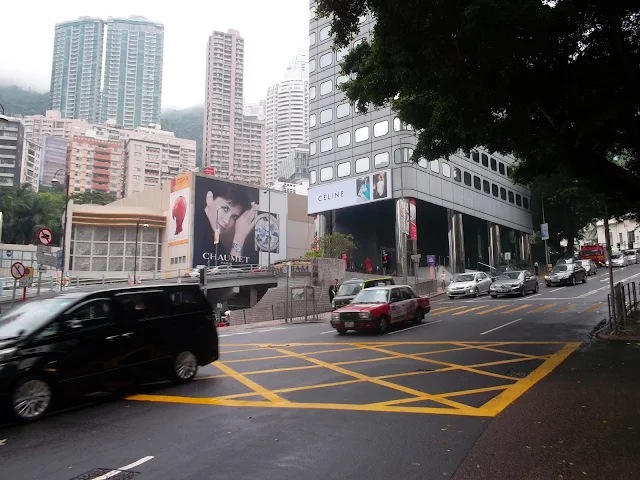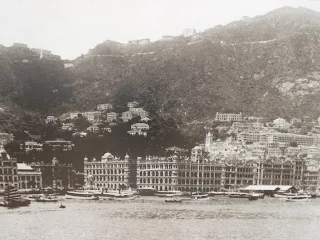The Peak is a must-see for every tourist coming to visit Hong Kong. Situated 1,200 feet above sea level, it commands an impressive view of Hong Kong's ultra-modern skyline and of its harbour.
Here British settlers who arrived in the 19th century sought to escape the heat and the crowds of the city. Built on the highest spot in Hong Kong island, the Peak was the very centre and symbol of Western power and of the authority and strength of British rule.
Today the Peak is renowned for being the location where one can enjoy the best panoramic view of the world-famous Hong Kong skyline and the harbour.
Here British settlers who arrived in the 19th century sought to escape the heat and the crowds of the city. Built on the highest spot in Hong Kong island, the Peak was the very centre and symbol of Western power and of the authority and strength of British rule.
Today the Peak is renowned for being the location where one can enjoy the best panoramic view of the world-famous Hong Kong skyline and the harbour.
How To Get To The Peak
The Peak is not close to the city centre, but it's very easy to reach thanks to the Peak Tram, a funicular tram that was completed in 1888 - in those days a masterpiece of Western technology. Before the construction of the tram, the only way to get there was to "hike up" the steep hill on foot, or to be carried there by local coolies on a sedan chair (see Wordie , pp. 73-74).
, pp. 73-74).
The Peak Tram station is only a few minutes away from Central MTR Station exit K. This exit leads to Statue Square, and from there you can turn left in the direction of Chater Garden, go straight and then turn right towards Garden Road (see map below).
The View of Hong Kong
What would Hong Kong be without its amazing skyline? This is the symbol of the city's dynamism, of its financial and economic might, of its vocation as a global metropolis at the crossroads between East and West. It is here that the success of Hong Kong becomes visible to the eyes of the visitor, a stunning proof of its breathtaking modernization, of its vitality and creativity.
The energy and spirit of the millions of people that have built this Eastern miracle seem to have sprouted from the earth to reach for the sky, and even its once so self-indulgent Western masters can't help looking at it with a mix of admiration, reverence, and perhaps envy.
On the other hand, this wonderful view is a veil that covers other, darker aspects of the city. But its visual power is so overwhelming that it indeed accomplishes its task: forgotten are all the flaws and imperfections hidden in the poorer, less fashionable districts, wiped away by the magnificent, imposing sight of the glamorous, wealthy, modern city.
The energy and spirit of the millions of people that have built this Eastern miracle seem to have sprouted from the earth to reach for the sky, and even its once so self-indulgent Western masters can't help looking at it with a mix of admiration, reverence, and perhaps envy.
 |
| View of Central and Victoria Harbour from the Peak in the first half of the 20th century |
 |
| A few houses on the Peak |
On the other hand, this wonderful view is a veil that covers other, darker aspects of the city. But its visual power is so overwhelming that it indeed accomplishes its task: forgotten are all the flaws and imperfections hidden in the poorer, less fashionable districts, wiped away by the magnificent, imposing sight of the glamorous, wealthy, modern city.
The Peak of Segregation: How Masters and Servants
Shared a City
 |
| The Peak Tram |
The Peak was both a sign of the authority, but paradoxically, also of the weakness of the Europeans. As historians have pointed out, Western colonists did not have as much power as they wanted the natives to believe. Europeans were clearly outnumbered and wouldn't have had the capacity to resist against repeated uprisings. One way in which they tried to compensate for the lack of real power was to represent power, to set up an awe-inspiring stage that would make the locals believe in European superiority (Carroll 2007
Hill stations often helped the British keep their identity and create a strong sense of community in an alien society. Here the British could "restore the physical and psychic energies they needed for their imperial tasks, replicate the social and cultural environments that embodied the values they sought to project" (see ibid., p. 92).
When the British settled in Hong Kong, one of their first concerns was to find a place where they could be and live 'British'. The Peak offered a good location. It was far away from the crowded 'Chinese-populated' quarters, and thanks to its height it was cooler than the at times unbearably hot city.
However, against the stereotype of the Western capitalist as opposed to the 'Chinese coolie', the Chinese population was a major driver in the economic development of Hong Kong, and numerous Chinese businessmen amassed considerable fortunes. Already in 1879-80 the Chinese provided 90 percent of government revenues (ibid., p. 69).
Accordingly to their social status, the Chinese upper class tended to move to the districts that the Europeans wanted to keep for themselves, and they indeed built or bought houses in the so-called Mid-levels, the area between Central and the hill districts.
Accordingly to their social status, the Chinese upper class tended to move to the districts that the Europeans wanted to keep for themselves, and they indeed built or bought houses in the so-called Mid-levels, the area between Central and the hill districts.
The European District Preservation Ordinance of 1888 sought to solve this problem by reserving "a certain portion of the Town [...] not for exclusively European occupation, but for houses built according to European models and occupied in much more limited numbers than is usual with Chinese" (Tsang 2011, p. 48).
This solution seemed acceptable, because it shifted the attention from racial segregation to hygienic concerns. In fact, the Europeans believed the Chinese lacked proper hygienic standards.
 |
| Colonial Hong Kong. Most of the old streets have now disappeared |
Nevertheless, this regulation was not considered sufficient by the expatriate community, and in 1904 the Peak Preservation Ordinance was issued, which specifically prohibited non-Europeans from settling in the area (Tsang 2011 , p. 48). According to the ordinance, the only Chinese allowed to reside there were servants, cooks, and drivers employed by Europeans (Carroll 2007, pp, 90-91).
, p. 48). According to the ordinance, the only Chinese allowed to reside there were servants, cooks, and drivers employed by Europeans (Carroll 2007, pp, 90-91).
However, racism during British rule was never absolute. The British were to a certain extent willing both to recognize the political and economic role of the natives, and also to make exceptions to the rules. For example, Robert Ho Tung, who was Eurasian but "adopted the manners, deportment, and costume of a Chinese gentleman and did not seek to pass as a European" was allowed to live on the Peak. He was the wealthiest man in Hong Kong and he was among the first Chinese to be knighted and thus be admitted into the upper class of the colonial and imperial society (Tsang 2011, pp. 48-49).










Comments
Post a Comment